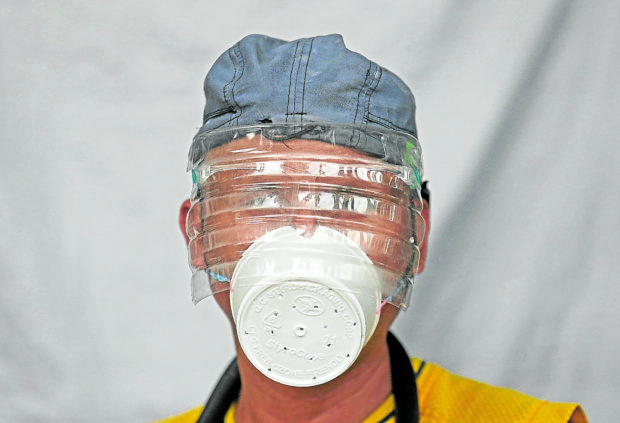
RECYCLED MATERIALS Tricycle driver Nestor Lazaro wears his own creations: a face mask that is actually a Styropor container and a face shield fashioned from a water container. The 53-year-old says his improvised shields are easier to breathe through as he waits for passengers outside a hospital in Manila. But will his protective gear get the approval of the Department of Transportation? |Photo by RICHARD A. REYES / Philippine Daily Inquirer
MANILA, Philippines — The Land Transportation Franchising and Regulatory Board (LTFRB) has issued an amended memorandum circular requiring not just passengers, but the drivers and conductors of public utility vehicles (PUVs) nationwide to also wear face shields starting Aug. 15.
Memorandum Circular No. 2020-33, which was issued by the LTFRB on Aug. 7, amended a previous memorandum that required PUV drivers and conductors to use just an eye protector or visor aside from the mandatory face mask.
DOTr requirement
Instead, they must now use full-face shields as required under the Department of Transportation’s (DOTr) MC 2020-14.
Those who fail to comply, according to the memorandum, will not be allowed to ride in the PUV.
The new measure is part of the DOTr’s stringent efforts to stop transmission of the new coronavirus disease (COVID-19) in PUVs nationwide. According to the LTFRB, the stricter health requirements will complement the opening of additional routes for people especially in areas that are now under general community quarantine.
In Metro Manila, all forms of public transport are banned as it remains under modified enhanced community quarantine until Aug. 18.
Added protection
In an earlier statement, Transport Secretary Arthur Tugade urged passengers not to look at face shields as an added cost or inconvenience, but as a necessary layer of protection against COVID-19.
According to a study done by the University of the Philippines-Philippine General Hospital, wearing both a face mask and a face shield, on top of practicing physical distancing, can reduce the chances of transmitting or contracting the virus by as much as 99 percent. INQ

